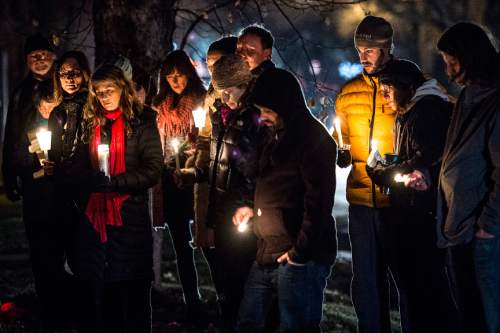This is an archived article that was published on sltrib.com in 2015, and information in the article may be outdated. It is provided only for personal research purposes and may not be reprinted.
Recent high-profile police shootings have the Utah Legislature looking at what steps might be taken statewide to prevent future incidents and how shootings that do occur should be investigated.
Sen. Mark Madsen, R-Saratoga Springs, said he recognizes that the number of shootings involving police officers — either where an officer or a citizen is shot — is small compared to the total number of interactions between the public and police.
"But I'm not willing to accept either of those numbers and I think this issue needs to be looked into for everyone's well-being," Madsen said.
The Legislature's Administrative Rules Committee recommended Tuesday the creation of a task force to study police shootings.
Sen. Howard Stephenson, R-Draper, said he envisions the task force would look at policies in place at police departments and whether they are are sufficient and uniform, would examine investigative practices when shootings occur, policies regarding the use of body cameras and the release of videos they record, and psychological testing and assistance for police officers.
There have already been three officer-involved fatal shootings in Utah this year.
Salt Lake City Police Chief Chris Burbank says his officers are trained to avoid using force and he will put Salt Lake's statistics up against those from any comparable department. But, as was the case in a recent shooting of James Dudley Barker in the city's Avenues neighborhood, sometimes officers have little choice.
In that instance, Burbank said, the officer was hit seven times by Barker, who was carrying a snow shovel. The officer's leg was broken and he had his Taser knocked away from him.
"What makes someone believe they can hit a police officer seven times with a shovel? That's a travesty," Burbank said, who added that the public and police need to respect each other. "It's on both sides. We need to evaluate how we can minimize this … but there needs to be respectful interaction on both sides."
While the policies for when an officer can use deadly force is fairly clear in state law, Ken Wallentine, retired chief of law enforcement at the Utah attorney general's office, said the policies for investigating shootings is not. Small departments frequently don't have the resources to conduct the kind of inquiries that those like Salt Lake City's are able to do, and that is an area the Legislature could address, Wallentine said.
Intensive training, he said, have been shown to be an effective way to reduce the frequency of incidents involving deadly force. Body cameras also have been shown to help, he said. In one department where Wallentine has worked as a consultant, the department saw a 60 percent drop in the use of force by officers in one year and citizen complaints dropped by 85 percent.
Scott Stephenson, director of Utah's police academy, said officers are trained at the academy on de-escalating encounters with upset civilians and how to interact with people with mental-health issues or other medical issues that affect their judgment. They are also trained in self defense and use of firearms.
And in every instance, the officer has the option to walk away, although that can be difficult.
"It's very hard to do when you're called to help and you're expected to do something by the person who called for assistance," he said.



